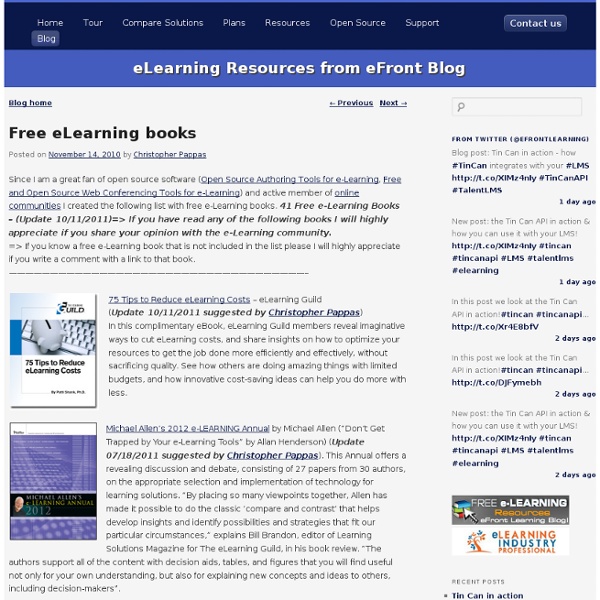Free eLearning books

Classroom 2.0
The Best Web 2.0 Applications For Education In 2011 — So Far
I usually just do a year-end list on Web 2.0 Applications For Education and many other topics, but it gets a little crazy having to review all of my zillion posts at once. So, to make it easier for me — and perhaps, to make it a little more useful to readers — I’m going to start publishing mid-year lists, too. These won’t be ranked, unlike my year-end “The Best…” lists, and just because a site appears on a mid-year list doesn’t guarantee it will be included in an end-of-the-year one. But, at least, I won’t have to review all my year’s posts in December… As usual, in order to make this list, a site had to be: * accessible to English Language Learners and non-tech savvy users. * free-of-charge. * appropriate for classroom use. * completely browser-based with no download required. It’s possible that a few of these sites began in 2010, but, if so, I’m including them in this list because they were “new to me” in 2011. You might want to visit previous editions: Feedback is welcome.
SOCIAL
FLIPPED
Khan Academy
new
Mind-reading robot teachers keep students focused - tech - 29 May 2012
An automated system that detects when online pupils are distracted or snoozing and then uses tricks to keep them alert WE ALL remember dozing off during a boring class at school. A robotic teacher that monitors students' attention levels and mimics the techniques human teachers use to hold their pupils' attention promises to end the snoozing, especially for students who have their lessons online. Tests indicate the robot can boost how much students remember from their lessons. Intelligent tutoring systems that use virtual teachers to interact with students could play a crucial role in the expanding field of online education. "We wanted to look at how learning happens in the real world," says Mutlu. The pair programmed a Wakamaru humanoid robot to tell students a story in a one-on-one situation and then tested them afterwards to see how much they had remembered. During this story the robot raised its voice or used arm gestures to regain the student's attention if the EEG levels dipped.
Five Best Practices for the Flipped Classroom
Ok, I'll be honest. I get very nervous when I hear education reformists and politicians tout how "incredible" the flipped-classroom model, or how it will "solve" many of the problems of education. It doesn't solve anything. It fosters the "guide on the side" mentality and role, rather than that of the "sage of the stage." It also creates the opportunity for differentiated roles to meet the needs of students through a variety of instructional activities. 1) Need to Know How are you creating a need to know the content that is recorded? 2) Engaging Models One of the best way to create the "need to know" is to use a pedagogical model that demands this. 3) Technology What technology do you have to support the flipped classroom? 4) Reflection Every time you have students watch a video, just like you would with any instructional activity, you must build in reflective activities to have students think about what they learned, how it will help them, its relevance, and more. 5) Time and Place
Related:
Related:



